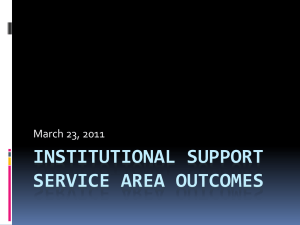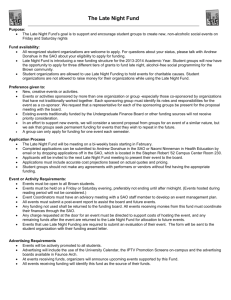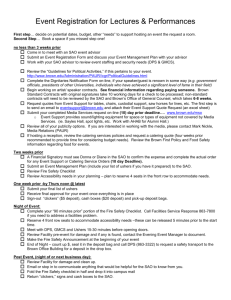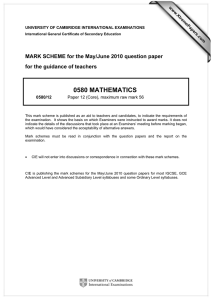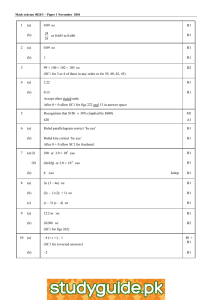Safety Code for Small Airborne Objects on Institutional Property
advertisement
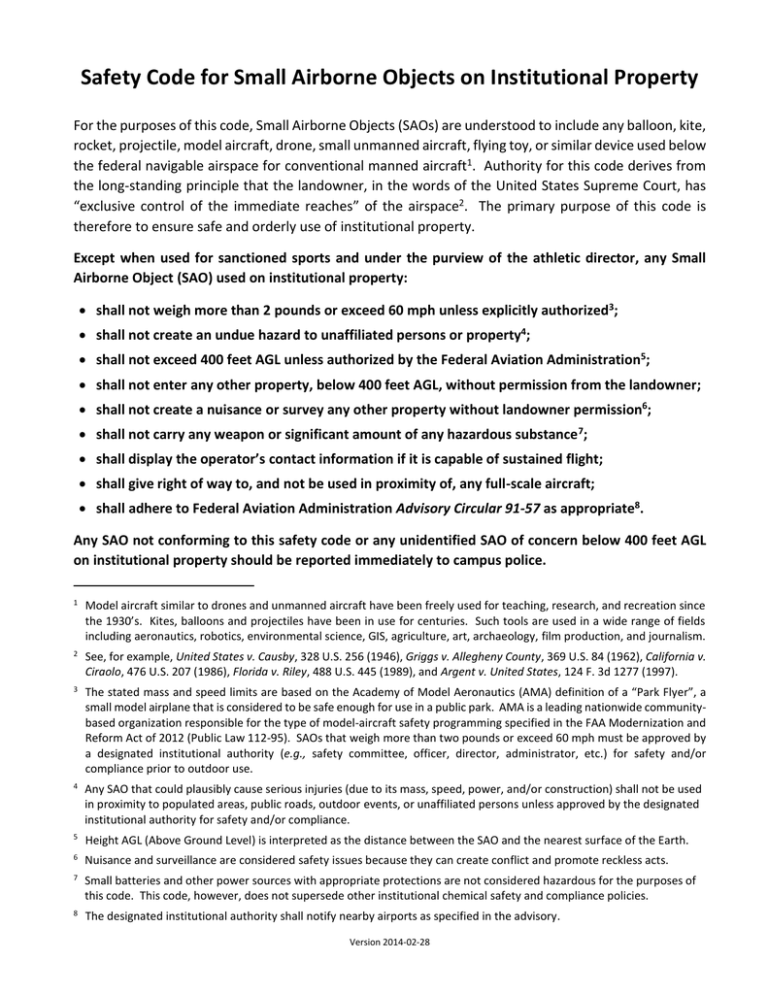
Safety Code for Small Airborne Objects on Institutional Property For the purposes of this code, Small Airborne Objects (SAOs) are understood to include any balloon, kite, rocket, projectile, model aircraft, drone, small unmanned aircraft, flying toy, or similar device used below the federal navigable airspace for conventional manned aircraft1. Authority for this code derives from the long-standing principle that the landowner, in the words of the United States Supreme Court, has “exclusive control of the immediate reaches” of the airspace2. The primary purpose of this code is therefore to ensure safe and orderly use of institutional property. Except when used for sanctioned sports and under the purview of the athletic director, any Small Airborne Object (SAO) used on institutional property: shall not weigh more than 2 pounds or exceed 60 mph unless explicitly authorized3; shall not create an undue hazard to unaffiliated persons or property4; shall not exceed 400 feet AGL unless authorized by the Federal Aviation Administration5; shall not enter any other property, below 400 feet AGL, without permission from the landowner; shall not create a nuisance or survey any other property without landowner permission6; shall not carry any weapon or significant amount of any hazardous substance 7; shall display the operator’s contact information if it is capable of sustained flight; shall give right of way to, and not be used in proximity of, any full-scale aircraft; shall adhere to Federal Aviation Administration Advisory Circular 91-57 as appropriate8. Any SAO not conforming to this safety code or any unidentified SAO of concern below 400 feet AGL on institutional property should be reported immediately to campus police. 1 Model aircraft similar to drones and unmanned aircraft have been freely used for teaching, research, and recreation since the 1930’s. Kites, balloons and projectiles have been in use for centuries. Such tools are used in a wide range of fields including aeronautics, robotics, environmental science, GIS, agriculture, art, archaeology, film production, and journalism. 2 See, for example, United States v. Causby, 328 U.S. 256 (1946), Griggs v. Allegheny County, 369 U.S. 84 (1962), California v. Ciraolo, 476 U.S. 207 (1986), Florida v. Riley, 488 U.S. 445 (1989), and Argent v. United States, 124 F. 3d 1277 (1997). 3 The stated mass and speed limits are based on the Academy of Model Aeronautics (AMA) definition of a “Park Flyer”, a small model airplane that is considered to be safe enough for use in a public park. AMA is a leading nationwide communitybased organization responsible for the type of model-aircraft safety programming specified in the FAA Modernization and Reform Act of 2012 (Public Law 112-95). SAOs that weigh more than two pounds or exceed 60 mph must be approved by a designated institutional authority (e.g., safety committee, officer, director, administrator, etc.) for safety and/or compliance prior to outdoor use. 4 Any SAO that could plausibly cause serious injuries (due to its mass, speed, power, and/or construction) shall not be used in proximity to populated areas, public roads, outdoor events, or unaffiliated persons unless approved by the designated institutional authority for safety and/or compliance. 5 Height AGL (Above Ground Level) is interpreted as the distance between the SAO and the nearest surface of the Earth. 6 Nuisance and surveillance are considered safety issues because they can create conflict and promote reckless acts. 7 Small batteries and other power sources with appropriate protections are not considered hazardous for the purposes of this code. This code, however, does not supersede other institutional chemical safety and compliance policies. 8 The designated institutional authority shall notify nearby airports as specified in the advisory. Version 2014-02-28 SAO Safety Code – Implementation Guidelines This document complements the SAO Safety Code by providing more detailed and specific guidance. It is anticipated that it may be updated periodically by the Safety Committee1 in response to new considerations that may arise. Except for common sporting and recreational objects such as balls and Frisbees, all SAOs used on Smith College property should follow the SAO Safety Code in accordance with the additional guidance below: 1. Compliance with College Safety Policy a. Students should not use SAOs outdoors without supervision from an accountable faculty or staff member. SAOs that could potentially inflict a serious injury require the presence of the accountable supervisor during outdoor use. b. As with other activities on campus, any injury or property damage caused by a SAO should be promptly reported to Campus Police. 2. Compliance with SAO Safety Code a. All SAO activity should be confined below the following heights2: 400 feet AGL at the MacLeish Field Station 250 feet AGL on the athletic fields 150 feet AGL elsewhere on the main campus The purpose of the lower height restrictions is to ensure that SAO activity remains safely below the navigable airspace for fixed-wing aircraft approaching the Northampton Airport. b. SAOs weighing less than 2 ounces are not restricted to any specific area of campus, but the supervising faculty or staff member is responsible for safe use. c. SAOs weighing more than 2 ounces, especially those capable of sustained flight, should generally be used on the athletic fields at a safe distance from unaffiliated persons, public roads, and events (see map). d. SAOs weighing more than 2 pounds are generally not appropriate for outdoor use on campus. These heavier SAOs may be used at the MacLeish Field Station with additional safety protocols and approval by the Field Station Manager. e. All SAOs that weigh more than 2 pounds or exceed 60 mph, including those used at the MacLeish Field Station, require Special Activity Approval by the Safety Committee. 1 The Safety Committee refers to the designated institutional authority responsible for SAO oversight at Smith College. This role is currently fulfilled by the Institutional Chemical Hygiene Committee (ICHC). 2 The Safety Committee may authorize the use of SAOs above the stated altitudes, provided that such activity complies with local, state, and federal regulations. Version 2014-03-07 Map showing general areas of the Smith College campus that are appropriate for SAOs weighing less than 2 ounces and for those weighing less than 2 pounds, provided that the conditions of the SAO Safety Code are met. In general, SAOs that are capable of sustained flight and weigh more than 2 pounds should only be used at the MacLeish Field Station with written approval from the Safety Committee and Field-Station Manager. Version 2014-03-07 SAO Safety Code – Special Activity Approval This document is required for Small Airborne Objects (SAOs) that weigh more than two pounds, exceed 60 mph, or otherwise may create a potential hazard. Such SAOs must be approved by the designated institutional authority prior to outdoor use. Summary of Activity: Use of small multirotors at the MacLeish Field Station Safety Issue: The weight of some multirotors may exceed 2 pounds Faculty Supervisor: Jon Caris (x3042), Bob Newton (x3946), Reid Bertone-Johnson (x3328) Description: SAOs with more than two propellers are known as multirotors. These battery-powered systems are often called multicopters, quadcopters, hexacopters, octocopters, etc. They are typically 1-2 feet in diameter and weigh less than 5 pounds. They are flown by radio control and can be programmed to fly semi-autonomously with additional safety measures. Multirotors are ideal platforms for capturing aerial images, particularly in confined areas. Potential Hazard: The weight of some multirotors may exceed the two-pound guidance in the SAO Safety Code. Their more powerful motors and larger propellers have the potential to cause injuries. In the unlikely event of a system failure, these heavier multicopters could fall and harm persons or property directly below. Safety Protocol: The safety measures below apply to the proposed special activity. All other requirements of the SAO Safety Code and Implementation Guidelines are also in effect. 1. The multirotor will be used within the Scientific Research Area below 400 feet AGL (see map). 2. The multirotor and its payload will not weigh more than 5 pounds. 3. The multirotor will not be flown directly over or near any non-participating persons. 4. The multirotor will not be flown autonomously without the possibility of intervention. 5. The multirotor will employ geofencing to prevent it from exiting the Scientific Research Area. 6. The operator will have a clear unaided view of the multirotor at all times during flight. 7. The operator will demonstrate knowledge of the Safety Code, proficiency with the multirotor, system reliability, safe lost-link behavior, and geofence functionality prior to any other use of the multirotor on field-station property. The evaluation should be done within the Test Area to the satisfaction of the Field Station Manager (see map). 8. The use of any SAO on MacLeish property, even those weighing less than 2 pounds, requires approval from the Field Station Manager. 2014-03-07 Map showing the Scientific Research Area for SAOs on MacLeish Field Station property. SAOs may only operate outside of this boundary (on MacLeish property) if the activity is explicitly approved by the Field Station Manager and all affected landowners. The inset Test Area is used for operator training and safety evaluations. The coordinates and maximum altitudes for the Scientific Research Area and Test Area are available from the Field Station Manager. 2014-03-07 SAO Safety Code – Special Activity Approval This document is required for Small Airborne Objects (SAOs) that weigh more than two pounds, exceed 60 mph, or otherwise may create a potential hazard. Such SAOs must be approved by the designated institutional authority prior to outdoor use. Summary of Activity: Outdoor water rocket flights for Fluid Mechanics (EGR 374) Safety Issue: Rockets may exceed 2 pounds, 60 mph, or 250 feet on the athletic fields Faculty Supervisor: Paul Voss (x4552), Drew Guswa (x7019) Description: Since 2007, water rockets have been used for a laboratory exercise in EGR 374, an upper-level engineering course in fluid mechanics. The typical rocket consist of a two-liter plastic soda bottle partially filled with water and pressurized with a bicycle pump. Lightweight fins, attached to the bottle with glue, provide directional stability. Upon release from a specially designed launcher, the rocket rapidly expels its water and accelerates upward. The empty rocket weighs approximately one pound. Potential Hazard: The rocket can travel at speeds of approximately 180 mph and may briefly weigh more than 2 pounds. The primary concern is that an unexpected trajectory could injure a person on the ground. Since the rocket can potentially reach heights of 300 feet above the surface, there is also the remote possibility of interfering with an unusually low-flying aircraft. Safety Protocol: The water-rocket activity has been conducted safely since it was first incorporated into EGR 374 in 2007. The following procedures will continue to be followed: 1. The activity will occur on the athletic fields when they are not in general use. 2. Any rocket expected to exceed 2 pounds or 60 mph will be separated from participants by a fence or net at least 15 feet tall1. 3. No participants will be allowed near the rocket when it is pressurized. The pump used to pressurize the rocket will located at a safe location approximately 15 feet away or on the other side of the aforementioned fence. The rocket will be launched by pulling a long string from the safe location. 4. Immediately before launch, participants will be asked to check for aircraft activity (audible or visible). Participants will also check that there are no other persons within approximately 500 feet of the launcher for a vertical launch or 500 feet in the general direction of travel for an angled launch. The rocket will not be launched until the area is clear. 5. All participants will be instructed to maintain full awareness of the rocket during its flight. 1 The backstop fences on the baseball fields are well suited for this purpose. Version 2014-03-31
